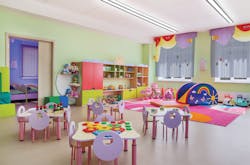Lighting has traditionally served one purpose in facilities – illuminating interiors. However, facilities managers can leverage new lighting technologies to make spaces more hygienic. They can do so without harming occupants with ultraviolet light or disinfecting chemicals.
Healthcare solutions company Vital Vio and lighting manufacturer Visa Lighting have developed their solutions to produce white light from LEDs. This lighting solution also disinfects areas by killing bacteria, mold and fungus that might harm occupants.
Hand-picked from interior+sources:
VISA Lighting and the Evolution of Lighting Technology
Disinfecting without Ultraviolet Light
“We’ve developed a white light disinfection technology,” says Tim Sharkey, Account Manager at Vital Vio. “We have a patented single-diode technology that disinfects and illuminates at the same time. Instead of using a color-mixing platform where you might have the violet chip next to other colors, we are down to a single chip level. This means we are not limited in form factor. We also get a high-quality white light out of that.”
The solution allows facilities to multitask. The LEDs emit pure white light that is free of ultraviolet light. It’s comfortable to work in at a wavelength that kills up to 70-80% of bacteria in a workspace.
“We work with specific wavelengths of light at about 400 to 450 nanometers,” says David Haar, Director of Strategic Marketing at Vital Vio. “Those wavelengths of light have been known to kill bacteria, mold and fungus since the late 1800s. But it hasn’t been until LEDs that we’ve been able to harness it in effective and meaningful ways.”
Lighting Safe for Humans
Because of their molecular structure, bacteria, mold and fungus can be killed with this white light, explains Haar. They react to wavelengths of light within this range, creating a build-up of reactive oxygen species. That causes the breakdown of cellular structures and kills the cells.
The Time is Now for Advanced Lighting Controls
Human cells don’t operate like this. This type of light is safe for exposure to skin and retinas, which can be damaged by ultraviolet light. Further, bacteria can’t build up a resistance to this light like it can against certain chemicals and antibiotics, which are often less sustainable anyway.
Using this type of light shouldn’t be your main disinfecting process. But it can provide an effective solution to mitigate sickness in spaces where there are many people like hospitals and schools.
Justin Feit was associate editor for BUILDINGS.
